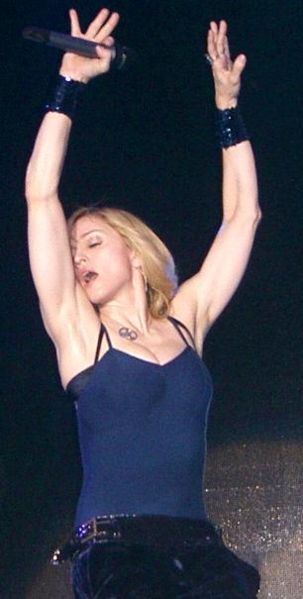 “Yoga is a metaphor for life. You have to take it really slowly. You can’t rush. You can’t skip to the next position. You find yourself in very humiliating situations, but you can’t judge yourself. You just have to breathe, and let go. It is a workout for your mind, your body and your soul.” Madonna.
“Yoga is a metaphor for life. You have to take it really slowly. You can’t rush. You can’t skip to the next position. You find yourself in very humiliating situations, but you can’t judge yourself. You just have to breathe, and let go. It is a workout for your mind, your body and your soul.” Madonna.
Madonna practices Ashtanga (aka astanga) yoga, which is a style which encourages more dynamic movements and transitions between the postures.
Astanga yoga can be an effective cardio workout as well as a isometric bodyweight bearing exercise.
Madonna began to practice ashtanga yoga (the Vinyasa style) to get back in shape after the birth of her daughter, Lourdes, in 1996. At this time she was with fitness trainer Carlos Leon who became her personal trainer. He may have been the source of her inspiration to adopt yoga as a way to stay in shape.
Now almost 12 years later, she is still in great shape, and has recently started a new world tour. For a 49 year old (50 years old this August) she is doing very well. So, what does Ashtanga yoga involve?
Ashtanga yoga practice consists of six progressively difficult series of linked postures, each requiring between 90 minutes to three hours to complete. Each sequence typically begins with 10 Sun Salutations and the standing poses. This is referred to as the “opening sequence”. The student then moves to either the Primary, Intermediate, Advanced A, B, C, or D, depending on his or her skill level, a back-bending sequence, finally closing with a set of inverted postures, referred to as the “finishing sequence”.
Ashtanga Yoga is traditionally taught in Mysore style (supervised self practice), where each student moves through the practice at his or her own pace and level. So, astanga yoga is not like the average yoga class you are likely to find in your local gym or village hall. It is much more dynamic, and requires a greater level of strength, coordination, balance and flexibility than other styles. This is why this form of yoga keeps Madonna in such great shape.
 Madonna’s enthusiasm for ashtanga yoga has since appeared in her work; Madonna chanted the opening ashtanga chant on her Ray-of-Light album, and also played an ashtanga teacher in the movie The Next Best Thing.
Madonna’s enthusiasm for ashtanga yoga has since appeared in her work; Madonna chanted the opening ashtanga chant on her Ray-of-Light album, and also played an ashtanga teacher in the movie The Next Best Thing.
However, she does not limit herself to yoga. She also enjoys horse-riding and gyrotonics, which is a set exercises derived from swimming, yoga, gymnastics, and tai chi, and is intended to improve flexibility and balance as well as muscle strength, and to increase overall flexibility and mobility in joints. It has been compared to and contrasted with Pilates but offers much more flexion.
So, if you wish to look slim, toned and sexy like Madonna when you are 50, you need to make a fitness routine, like Ashtanga yoga, a daily event.












![[ashtanga-yoga.jpg]](https://blogger.googleusercontent.com/img/b/R29vZ2xl/AVvXsEh5UiDCIqFA12kwt3SrQFhEJ8Q8SwzAC99ts5xepZrX56i0Tv4l8aN5H9oGDGytJ1WYiuaxfCQibB4MkAx18MjmDGewrmzcgdrZWRC7zX27MLQZr9mltkKIzC2aaEhJl5aXwSkE2d_watOX/s1600/ashtanga-yoga.jpg)

+build+the+fundament+for+Ashtanga+Vinyasa+Yoga+Practice.jpg)







